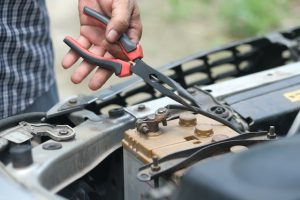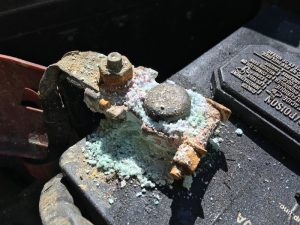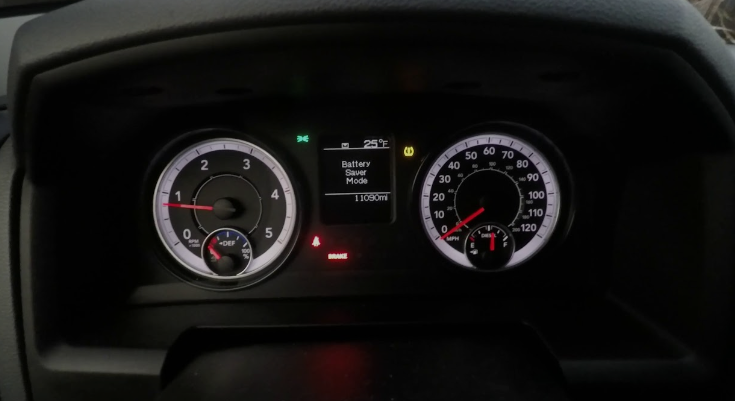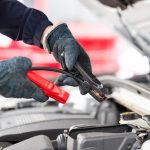Most ICE vehicles are equipped with 12-volt batteries that supply power to all of the electrical equipment, including the radio, taillights, headlights, interior lights, air conditioning units, horns, fuse boards, etc. This load is sufficient to quickly drain the battery without recharging it.
The manufacturer includes automobile alternators as a battery charging system and keeps them from running flat. A serpentine belt connects the alternator to the engine. The manufacturers built the alternator to manage voltage between 14.2 and 14.7, which is higher than the battery’s voltage of 12.4 to 12.8. By doing this, the alternator can recharge the battery and restart the flow of electricity to all the car’s electrical devices.
Assume that the battery cannot maintain its charge or provide the necessary electric flow to run all electrical equipment. In such a case, the driver information center of the car computer will then show car warning signs like a battery saver active alert.
This article goes into great detail about what is battery saver active, what causes it, and the potential fixes. For more information, keep reading.
What Does Battery Saver Active Mean?
A battery saver active signifies the battery is weak, not retaining a charge, or is going low. Additionally, the vehicle’s computer is turning off a few electrical devices that could drain the battery and leave you stuck.
Your battery and alternator cannot supply enough power flow to maintain some systems, as indicated by the alert on the driver information center.
What Does Battery Saver Do?
When the battery and the alternator are not supplying enough electric flow, a battery-saver active system is a crucial component that maximizes the battery current. The battery sensor and your powertrain control unit interact to detect and analyze your vehicle’s charging system. It extends the life of your battery and avoids an abrupt shutdown.
Let’s first examine typical reasons behind the battery-saver active on the Chevy Malibu and other vehicles.
The Causes:
A few things can trigger the powertrain control module (PCM) to display a battery saver active alarm signal on your dashboard, similar to various system problems in an automobile. The following are some prevalent causes why the warning light might come up.
Bad Battery
Weak batteries are one of the frequent reasons why the vehicle’s battery-saver mode is activated. So, attempt to check the battery life whenever the warning light on your dashboard illuminates.
The sensor will alert the engine control unit if the battery deteriorates and discharges to 12.4 volts or below. Non-essential systems will be turned off by the car computer, keeping only those necessary for the finest potential vehicle movement operative.

Bad Current Sensor
A current sensor in a car battery can also be a major culprit behind the trouble. It is responsible for monitoring the amount of current supplied to the battery and used by different accessories. Therefore, it keeps a balance and protects your car battery from overcharging and out-of-charging issues.
When car accessories cross the limit of current usage or current usage exceeds the amount supplied to the car, it alerts the system, and the car battery saver becomes on. In some cases, these sensors become damaged and start activating battery sensors without reason. You can use a digital multimeter to check the sensor and diagnose a problem with its reading.
Lousy Alternator
There could be problems that stop the alternator from charging the battery. The battery-saver mode will be activated on any car model, including the Chevy Impala, via the ECM. If the warning light appears while driving, your alternator is probably broken, or your battery connection is loose.

Broken Alternator Belt
As mentioned earlier, alternators are responsible for charging the battery, and any problem or damage to one or more parts can stop it from working. Every alternator has a belt that spins the battery and starts the charging process.
When the alternator becomes loose, damaged, or broken, it fails to spin the battery. As a result, a battery-saver active notification pops up on your dashboard. Therefore, always make sure the car alternator belt is tight and in the right working order.
Lose or Lousy Battery Cables
Loose or damaged battery wires may cause car accessories to experience sporadic electric flow. Corrosions can potentially be the culprit. Your battery connections may still cause problems though they appear to be okay.
You should only apply an anti-rust product and clean the terminals and cables to resolve the issue. Moreover, this will stop the battery cables from rusting soon.

Lousy Battery Sensor
The car battery sensor controls and analyzes the net voltage applied to the car battery and the battery-electric flow. The saver mode on the dashboard is activated when the sensor detects that the electric discharge from the battery is less than 12.4, which relates to the vehicle computer.
A persistent negative current can also cause the driver information center to display a warning message (DIC). Car accessories draw more current through negative current than the alternator’s voltage output does.
How To Fix Battery Saver Active?
Since there are multiple reasons why battery saver active warning messages arise, there are also solutions to fix the issue and prevent it from happening again soon.
Replace The Faulty Sensor
If your scan tool detects a problem with the battery sensor, either the sensor is defective or is not installed correctly. After changing your battery or alternator, if the warning light still illuminates, you probably did not install the sensor correctly. If, however, the warning light appears while driving without any prior repair on the charging system, you might need to replace the sensor.
Fixing Weak Connections
Battery-saver active warning messages are often caused by poor or loose battery connections. Simply tightening a couple of nuts on the terminals or cleaning the terminals of corrosion can solve the problem. However, in some cases, you may have to replace the terminals if the corrosion is severe.
Replace a Faulty Battery
If the battery is dead, you must replace it. Since it typically lasts four to six years, it might be time to change yours if it has been a while. You can examine it or take it to a nearby auto parts shop.
Replace Faulty Alternator
If the alternator breaks out, the battery cannot be recharged. The symptoms of a dead battery will still be present even when the alternator is the issue. You can test the alternator or bring it to a nearby auto parts store.
FAQs:
Does Battery Saver Active Mean I Need A New Battery?
No, it depends on the reason behind the message. Multiple reasons, such as a bad alternator, faulty sensor, broken belt, and damaged wires, can cause this issue. Battery replacement is needed only when you have a bad battery. Therefore, check the culprit behind the issue before replacing your battery or taking any other measures to fix the problem.
How Long Can I Drive When the Battery Saver Active On Car?
It depends upon the current you left in your battery. When a battery saver is active on a car, it allows you to save maximum by cutting the supply to other accessories such as the radio and help you to run the vehicle longer. You can drive the car for a few minutes to hours.
How To Recover From This Situation?
It mainly depends on the reason behind this issue. Therefore, all you need to cope with the battery saver active issue is to diagnose the reason. You can use this guide to know about major culprits that can cause this problem and how to fix it properly. The best way to fix the problem permanently is to send it to a creditable service station.
Wrap Up
The helpful technology known as battery saver active keeps cars from shutting down because of corroded terminals, a failing alternator, or a dying battery.
Your car battery is an essential part that enables you to start and maintain the car’s functioning. So, if you find any issues, look over the likely causes and automotive tips listed above to resolve them. Contact a qualified mechanic to solve the problem if you lack the confidence or faith in your abilities to do so.
Last Updated on May 6, 2023 by Umar Tanveer

Mac is an Automotive enthusiast. He owns up to 15 vehicles. He deals with Auto problems and shows his skill to Car owners who are seeking any type of Car help.





